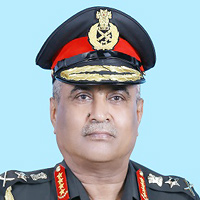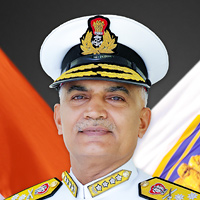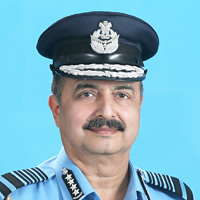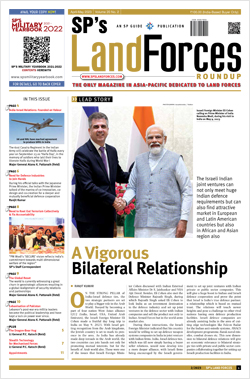INDIAN ARMED FORCES CHIEFS ON
OUR RELENTLESS AND FOCUSED PUBLISHING EFFORTS

SP Guide Publications puts forth a well compiled articulation of issues, pursuits and accomplishments of the Indian Army, over the years

I am confident that SP Guide Publications would continue to inform, inspire and influence.

My compliments to SP Guide Publications for informative and credible reportage on contemporary aerospace issues over the past six decades.
- Interim Defence Budget 2024-25 — An Analysis
- Union Defence budget 2024
- Indian Army: In quest of greater firepower and policy recommendations for gaps
- Indian Army Annual Press Conference 2024
- 6G will transform military-industrial applications
- Tata Boeing Aerospace Delivers 250 AH-64 Apache Fuselages, Manufactured in India
Fighting Terror: Armies in New Urban Warfare
Navigating the realities of Urban Warfare and lessons drawn from the ongoing global fight against terror

By the time the dramatic events of 9/11 triggered the US led Global War on Terror (GWOT), India had been fighting its own war on terror for over a decade. Only difference was that the west and especially the US had refused to recognise the gravity of Pakistan’s use of terror as an instrument of state policy because of their own narrow geopolitical interests. Having failed to take Kashmir first in 1948 and 1965 and after a humiliating defeating the 1971 war which saw the surrender of 93,000 Pakistani troops, then Pakistan Prime Minister Bhutto laid down the doctrine of continuing the conflict by “inflicting a thousand cuts” on India. His Army Chief General Zia-ul-Haq deposed Bhutto in a military coup, had him executed and later gave shape to the thousand cuts policy.
Fighting the Global War on Terror
A nascent Khalistan movement was fanned by the ISI, which trained and armed young Sikhs to wage a violent secessionist insurgency that lasted for over a decade starting mid-80s. Operation Blue Star was launched in 1984 by the Indian Army to flush out terrorists from the sacred Golden Temple, giving it first-hand experience of the immense challenges of fighting terror in urban builtup areas. The secessionists then assassinated Indian Prime Minister Indira Gandhi as a revenge and entrenched themselves in the towns and villages of Punjab. The ensuing intense firefights took a heavy toll. 1,714 security personnel, 1,700 soldiers, 7,946 militants, and 11,690 non-combatants were killed throughout the conflict.
After the conclusion of the Soviet–Afghan War in 1989, when the fighters of the Sunni Mujahideen and other Islamic militants duly aided by the US successfully removed the Soviet forces from Afghanistan, a more sinister phase began. Pakistan sought to utilise these “free and jobless”militants in the Kashmir and elsewhere, in accordance with the “thousand cuts” doctrine so as to “bleed India”. From late 1980s, there has been the serial bomb blast in Mumbai in 1993, attack on India’s Parliament in December 2001, attack on Akshardham temple in Ahmedabad in September 2002, and the Mumbai terror attacks on November 26, 2008. All the while the Kashmir Valley was kept on the boil. Since then the Indian Army has been fighting a relentless war, its tactics, techniques, and procedures (TTPs) evolving over the years.
Every urban battle is unique and shaped by the cityscape, human terrain, and forces. Even so, comparing the war in Gaza with other urban battlefields and combatants is a useful first step
Having failed to achieve its goals through three conventional military campaigns and then through a violent secessionist insurgency in Punjab, Pakistan switched to terror as its instrument. It is important here to very briefly touch on the subject of distinguishing terrorism from both conventional and insurgency/guerrilla warfare. Although conventional military forces invariably engage in psychological warfare against the enemy, their principal means of victory is strength of arms. Similarly, guerrilla forces, which often rely on acts of terror and other forms of propaganda, aim at military victory and occasionally succeed (e.g., the Viet Cong in Vietnam and the Khmer Rouge in Cambodia). Terrorism on the other hand is the calculated use of violence to generate fear, and thereby to achieve political goals, when direct military victory is not possible. That sums of the type of war being waged by Pakistan for the past three decades and by Hamas and the Hezbollah as well as Iran’s proxies like the Houthis in Yemen, who have opened a new front in the Red Sea.
In this backdrop, the launching of GWOT, from Indian point of view was just another chapter of a conflict it was already fiercely combating. But a distinctly new dimension to war on terror emerged when the US, backed Iraqi Army, battled the ISIS militants in Mosul over nine months in 2016-17. In the second largest city of Iraq after Baghdad, the gruelling urban battle resulted in thousands of ISIS terrorist killed alongside some 8,200 Iraqi troops and over 10,000 civilians apart from thousands of buildings damaged or destroyed. Urban offensives accounted for eight times more conflict-related civilian fatalities in four governorates in Iraq and Syria (March 2017-July 2018) than fighting in other areas, the International Committee of the Red Cross said in a report in October 2018.
Around the same time another urban theatre in the war against terror unfolded thousands of miles away in the city of Marawi situated on the southern island of Mindanao in the Philippines. In 2017, hundreds of militants swearing allegiance to ISIS launched a surprise takeover of the city declaring it a new caliphate of ISIS. Philippine security forces fought back, waging ground and air assaults, with military support from the US, Australia and China, in what became the country’s largest battle since World War II. On May 23, 2017, government forces carried out heavy bombing of the city to drive out the armed fighters from two ISIL-affiliated groups – Abu Sayyaf and the Maute, leaving Marawi in ruins and more than 1,000 people killed. The United Nations says 98 per cent of Marawi’s population of nearly 2,00,000, as well as others in nearby municipalities, were displaced by the fighting.
Urban Warfare Realities
Armies around the world were taking note of the complexities of fighting terror in urban settings. In the desert, troops usually can see the enemy coming and can manoeuvre with ease. Forests, jungles and mountains strain equipment and logistics, taxing mobility. But a city is a whole other matter. Some aspects of urban combat remain the same, regardless of the era or region. Buildings, tunnels and other obstacles hide defenders, rubble impedes vehicles and provides ample opportunities for booby traps, civilians who remain pose a challenge to forces intent on reducing casualties. The presence of civilians also provides terrorists a way to blend into the population. Every inch of territory gained consumes more ammunition, supplies and by its intense nature, creates higher casualty counts, requiring more troops than an operation in any other terrain.
As the ensuing war in Gaza demonstrates, there are no fixed positions in urban warfare, and war is waged in a completely complex and multidimensional environment. Urban offensives cause devastation and quickly lead to sharp spikes in casualties - both because of the fighting itself, and because of these battles’ compounding effects. International condemnation and cries for immediate ceasefire ensues.

Rocket fire has been the primary means that Hamas and other groups, such as Hezbollah, have used to attack Israel over the years. But unlike conventional military attacks where rockets are arranged in various areas of the battle space, often in view of drones or aircraft, the combination of tunnels and rockets gives Hamas ways to strike and move rapidly without detection. Moreover, Hamas differs from the opponents in Mosul, Raqqa, and other smaller urban battles in Afghanistan, Iraq and Syria. It is certainly on par with IS in its ability to conduct suicide bombings, and probably superior in anti-armour warfare, drone operations, and air defence.
And while IS had around two years to prepare Mosul and Raqqa’s defence, Hamas has had fifteen years to prepare a dense “defence in depth” that integrates subterranean, ground-level, and above-ground fortifications, communication tunnels, emplacements, and fighting positions, as well as potential minefields, improvised explosive devices, explosively formed penetrator antiarmour mines, and buildings rigged as explosive booby traps. Much of the infrastructure such as schools, hospitals and mosques have been dual-purposed with Hamas command and control, observation and firing positions. Such buildings can often weather missile strikes better than residential or commercial buildings and the presence of civilians can sometimes deter such strikes entirely. As important, even after the brief pause that allowed an exchange of hostages for Palestine prisoners languishing in Israeli jails, Hamas is still holding about a hundred Israeli and foreign hostages by most accounts, an unprecedented complication.
Lessons from Urban Battlefields
Every urban battle is unique and shaped by the cityscape, human terrain, and forces. Even so, comparing the war in Gaza with other urban battlefields and combatants is a useful first step. Many lessons emerge.
Firstly, destruction of urban areas is almost unavoidable. Every urban battle eventually becomes a choice between saving the physical environment and saving the lives of friendly troops. Faced with such a decision, attackers generally choose the latter, especially once they become weary. In West Mosul, which humanitarian agencies consider an extraordinarily destructive battle, the UN certified that over 13,000 structures were demolished or made uninhabitable in about 180 days of battle. In the more concentrated Raqqa area, the figure was 11,000 (or 80 per cent of the city’s structures) in 90 days.
Secondly, tactics, timing, and troop quality matter. Urban battles are especially unforgiving of mistakes, lethargy, and low-quality or exhausted troops. So, even though some experts say that of all the militaries in the world, Israel is the best trained, equipped and positioned for fighting an urban campaign, it faces an uphill task.
Thirdly, fighting terror in urban settings tend to be long-drawn. Any initial plannings with regard to length of the conflict is proved wrong immediately as the ground battle commences. In the war against IS, the US supported 277 days of urban fighting in Mosul and 90 days in Raqqa. In comparison, the US pressured Israel to shut down its December 2008 Gaza operation after 22 days and its 2014 operation after 49 days, even though they were less destructive than any of the urban operations against IS. In the current Gaza conflict, the international community through multiple resolutions in the UNGA started demanding for an immediate ceasefire barely weeks into the war. It is unlikely that there would be any as the war enters its fourth month if Israel stays focussed on its war aims of eliminating Hamas from the Gaza strip at least.
India’s Restraint and Nuanced Approach
In comparison, India has been waging its war on terror with utmost restraint, minimising collateral damage and casualties to civilians. In the Kashmir valley, there has been absolutely no use of indiscriminate aerial bombing or even shelling and RPG salvos have been very selectively used to bring down a building or two only after confirming presence of militants inside and safely evacuating civilians in the vicinity. It has vigorously pursued a political solution in order to isolate the terrorists from mainstream population through multiple developmental initiatives as much as it has demonstrated its resolve to effectively counter the cross-border terrorism though covert and over operations.
Urban offensives cause devastation and quickly lead to sharp spikes in casualties - both because of the fighting itself, and because of these battles’ compounding effects
The first-hand experience of fighting terror over three decades has guided India to take a nuanced stand in the Gaza conflict, resolutely standing behind Israel in its hour of grief while voting with utmost discretion at the UNGA. With the ISKP (Islamic State of Khorasan Province) establishing a foothold in Pakistan alongside other established terror groups like the TTP, Myanmar slipping into chaos, ISI backed groups in Bangladesh waiting to strike and Maldives choosing its sides, India has to confront terror for a long time to come. It is vital that the Indian Army must carefully observe and analyse each phase and each manoeuvre of the war in Gaza to draw its own lessons in the everevolving war on terror.





